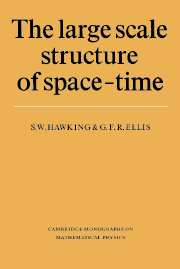Book contents
- Frontmatter
- Contents
- Preface
- 1 The role of gravity
- 2 Differential geometry
- 3 General Relativity
- 4 The physical significance of curvature
- 5 Exact solutions
- 6 Causal structure
- 7 The Cauchy problem in General Relativity
- 8 Space–time singularities
- 9 Gravitational collapse and black holes
- 10 The initial singularity in the universe
- Appendix A Translation of an essay by P. S. Laplace
- Appendix B Spherically symmetric solutions and Birkhoff's theorem
- References
- Notation
- Index
4 - The physical significance of curvature
Published online by Cambridge University Press: 26 January 2010
- Frontmatter
- Contents
- Preface
- 1 The role of gravity
- 2 Differential geometry
- 3 General Relativity
- 4 The physical significance of curvature
- 5 Exact solutions
- 6 Causal structure
- 7 The Cauchy problem in General Relativity
- 8 Space–time singularities
- 9 Gravitational collapse and black holes
- 10 The initial singularity in the universe
- Appendix A Translation of an essay by P. S. Laplace
- Appendix B Spherically symmetric solutions and Birkhoff's theorem
- References
- Notation
- Index
Summary
In this chapter we consider the effect of space–time curvature on families of timelike and null curves. These could represent flow lines of fluids or the histories of photons. In §4.1 and §4.2 we derive the formulae for the rate of change of vorticity, shear and expansion of such families of curves; the equation for the rate of change of expansion (Raychaudhuri's equation) plays a central role in the proofs of the singularity theorems of chapter 8. In §4.3 we discuss the general inequalities on the energy–momentum tensor which imply that the gravitational effect of matter is always to tend to cause convergence of timelike and of null curves. A consequence of these energy conditions is, as is seen in §4.4, that conjugate or focal points will occur in families of non-rotating timelike or null geodesics in general space–times. In §4.5 it is shown that the existence of conjugate points implies the existence of variations of curves between two points which take a null geodesic into a timelike curve, or a timelike geodesic into a longer timelike curve.
Timelike curves
In chapter 3 we saw that if the metric was static there was a relation between the magnitude of the timelike Killing vector and the Newtonian potential. One was able to tell whether a body was in a gravitational field by whether, if released from rest, it would accelerate with respect to the static frame defined by the Killing vector.
- Type
- Chapter
- Information
- The Large Scale Structure of Space-Time , pp. 78 - 116Publisher: Cambridge University PressPrint publication year: 1973
- 2
- Cited by



